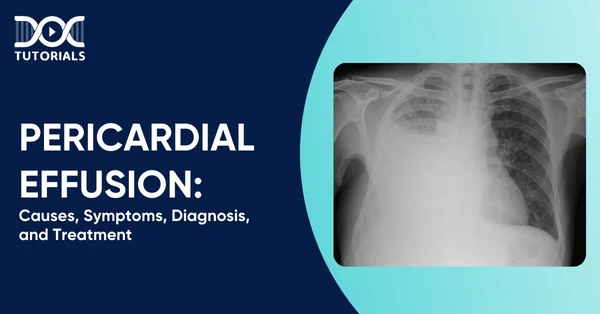Pericardial Effusion: Causes, Symptoms, Diagnosis, and Treatment

Pericardial effusion, or the presence of an excessive amount of fluid surrounding the heart, occurs in approximately 3% of the population, with a reported prevalence ranging from 5.7% to 9%. Although it can occur in any individual of any age or ethnicity, the primary reasons for pericardial effusion vary by location, age range, and health status.
In developed countries, viral pericarditis is the most common offender, while in developing countries, tuberculosis is a frequent cause. The other causes are kidney failure (uremia), neoplastic diseases, and idiopathic causes with no known aetiology.
Understanding the causes, symptoms, and risk factors of pericardial effusion is crucial for ensuring early treatment and effective long-term management. Additionally, if you are an aspiring NEET PG medical student, learning about this condition is vital for expanding your clinical knowledge and improving patient care.
Continue reading to learn more!
What is Pericardial Effusion?
Pericardial effusion is the excess of fluid in the two-layered sac covering the heart, the pericardium. In a healthy state, there is always some fluid between the layers to decrease friction. If the pericardium is damaged or becomes diseased, inflammation will create fluid accumulation.
This excess fluid may also develop without inflammation, for example, due to internal bleeding, some cancers, or trauma to the chest. When there is excessive accumulation of fluid, it may compress the heart, affecting its functioning. If not treated on time, this medical condition can lead to complications such as heart failure or even death. However, early detection can lead to better outcomes.
What are the Symptoms of Pericardial Effusion?
Generally, individuals do not experience pericardial effusion symptoms if the condition is minor. However, when the fluid accumulates rapidly, becomes excessive, or leads to a complication like cardiac tamponade, symptoms are more likely. The primary symptoms include:
- Shortness of breath
- Pain or pressure in the chest
- Palpitation or tachycardia (abnormal palpitations or fast heartbeat)
- Dizziness or lightheadedness
- Syncope (loss of consciousness)
- Chronic fatigue
- Restlessness, behavioural change due to reduced blood flow to the brain
- Cyanosis, bluish colouration of lips or nail beds due to reduced oxygen supply
If the effusion grows bigger in size, it can compress adjacent structures or nerves, causing other symptoms such as:
- Dysphagia
- Intractable hiccup
- Cough or voice change
These pericardial effusion symptoms may also differ in severity depending on the rate at which fluid accumulation occurs and the cause of pericardial effusion.
What are the Causes of Pericardial Effusion?
There are numerous potential pericardial effusion causes. The most frequent are as follows:
- Inflammation of the pericardium, or pericarditis
- Infections, such as viral infections due to HIV and bacterial infections due to tuberculosis
- Fungal and parasitic infections are other potential causes of pericardial effusion
- Autoimmune diseases, including rheumatoid arthritis, lupus (SLE), and Sjögren syndrome
- Endocrine or hormonal conditions like delayed hypothyroidism or ovarian hyperstimulation syndrome
- Blunt chest trauma due to accidents, stab wounds, or gunshot injuries
- Cardiovascular illnesses like heart attack, congestive heart failure, or aortic dissection
- Side effects of treatment such as open-heart surgery, radiotherapy, or medication
- Long-standing disease complications like chronic kidney disease, end-stage renal failure, or liver cirrhosis
In other cases, physicians fail to diagnose a specific cause. Such cases are known as idiopathic pericardial effusions. It is essential to understand the causes of pericardial effusion so that it can be diagnosed early and treated appropriately.
How is Pericardial Effusion Diagnosed?
When pericardial effusion is being diagnosed, the doctor will get a history of your general health and conduct an adequate physical examination. Normal findings can be low blood pressure, elevated heart rate of over 100 bpm, muffled cardiac sounds, and bulging neck veins. If there is cardiac tamponade, your systolic blood pressure will fall more than 10 mmHg during inspiration.
To confirm the diagnosis, your doctor may order one or more of the following tests:
- Electrocardiogram (EKG): Traces electrical impulses of the heart and keeps track of an abnormal heartbeat
- Chest X-ray: May demonstrate a big, rounded size of the heart if fluid buildup is significant and persistent
- CT Scan or MRI: Help detect pericardial effusion, but these tests are not the most appropriate tests for this medical condition
- Echocardiogram (ultrasound of the heart): Best test to evaluate for the presence and size of the effusion and any evidence of tamponade
After diagnosis, additional tests may be required to determine the cause of the pericardial effusion. These include:
- Complete Blood Count (CBC): Identifies infections
- Troponin Levels: Evaluates injury to the heart muscle
- BNP (B-type natriuretic peptide): Evaluates possible heart failure
- TSH (thyroid stimulating hormone): Checks for thyroid dysfunction
- Autoimmune Screen: Identifies immune system-related conditions
- Pericardiocentesis: Used to diagnose infection or other abnormality of the fluid
All these measures assist physicians towards an individualised regimen of pericardial effusion treatment encompassing both the symptoms and the aetiology. Early detection and treatment are essential for preventing subsequent complications and ensuring a successful recovery.
What is the Treatment of Pericardial Effusion?
Pericardial effusion treatment relies on numerous factors, such as:
- The amount of fluid accumulated
- The etiology of pericardial effusion
- Whether or not cardiac tamponade develops or may develop
Based on the above-mentioned factors, pericardial effusion treatment involves the following:
- Medications
If there is no immediate danger of cardiac tamponade, or it has not yet occurred, your doctor can recommend medication to manage inflammation in the pericardium. The most commonly prescribed ones are:
- Aspirin
- Nonsteroidal anti-inflammatory drugs (NSAIDs), including ibuprofen (Advil, Motrin IB, etc.)
- Colchicine (Colcrys, Mitigare, etc.)
- Corticosteroids such as prednisone
These drugs are usually indicated when symptoms of pericardial effusion are controlled, and the aetiology is inflammation.
- Surgery or Other Procedures
If medicine fails, or in cases of massive effusion where the risk of cardiac tamponade is high, surgery or other procedures might be necessary. Your doctor might suggest intervention when:
- Medicine can’t reverse the pericardial effusion
- Symptoms are very severe, and the likelihood of tamponade is high
- Cardiac tamponade has already developed
Procedure treatments for pericardial effusion commonly include:
- Pericardiocentesis (Drainage of Fluid): Excess fluid is drained by placing a needle into the space surrounding the heart. A catheter is then placed to ensure ongoing drainage, assisted by echocardiography to ensure accuracy. The catheter typically remains in place for a short period of two days to prevent fluid from building up again and is removed once drainage stops and reaccumulation no longer occurs.
- Open-heart Surgery: In the event of internal bleeding, particularly after cardiac surgery or trauma, open-heart surgery might be required. It enables the surgeon to perform drainage and even repair the damage. In some cases, a tract is created for the spontaneous drainage of fluid into the abdominal cavity.
- Pericardiectomy (Pericardium Removal): If effusions persist and recur despite prior therapy, the optimal treatment is the removal of all or a portion of the pericardium. This is usually considered when repeated episodes impact heart function or quality of life.
How Long Does It Take to Recover from Pericardial Effusion?
The time taken for the pericardial effusion to heal will depend on a number of key factors:
- Causes of pericardial effusion
- Severity of the fluid buildup
- Type of treatment of the pericardial effusion
- Your overall health and any other underlying conditions
If you were experiencing cardiac tamponade, you might feel noticeably better soon after the fluid is drained, as pressure on the heart is relieved. Your healthcare provider is the most reliable source for estimating how quickly you can expect to recover and return to normal activities.
FAQs About Pericardial Effusion
- How quickly can pericardial effusion develop?
The condition occurs when fluid builds up between the heart and the pericardium. It can develop suddenly, sometimes in less than a week. Chronic forms may progress more slowly, lasting for more than three months. Prompt recognition of pericardial effusion symptoms is key to avoiding complications.
- Is pericardial fluid infectious?
Indeed, infection is a frequent aetiology of pericardial effusion. It can be caused by viruses, bacteria, fungi, or even parasites. Inflammatory and autoimmune conditions, such as lupus, rheumatoid arthritis, and Sjögren syndrome, are also frequent etiologies of pericardial effusion secondary to infection or inflammation of the pericardial sac.
- Can pericardial effusion cause tachycardia?
In its more advanced forms, especially with cardiac tamponade, high pericardial pressure can severely impair blood circulation. Following pressure greater than 25 mm Hg may lead to pulsus paradoxus, markedly decreased blood pressure, and increased heartbeat rate (sinus tachycardia). Without immediate treatment, this condition may worsen extremely fast and lead to shock or even death.
- Can you exercise with a pericardial effusion?
Athletes or physically active individuals with mild or asymptomatic pericardial effusion found incidentally during imaging may not need to restrict physical activity, provided there’s no evidence of myocardial inflammation. However, a doctor’s evaluation is necessary before returning to any sport or exercise routine.
- What foods cause pericarditis?
Although certain foods do not trigger pericarditis or pericardial effusion directly, the intake of processed foods, trans fats, and sugars will lead to systemic inflammation. This may slow down healing and worsen the condition. The selection of anti-inflammatory foods like vegetables, fruits, whole grains, and omega-3 foods will help in healing and cardiovascular health.
Conclusion
Pericardial effusion, fluid buildup around the heart, can be alarming, especially when its cause isn’t immediately apparent. The good news is that with timely diagnosis and appropriate treatment, most people experience significant improvement. Always feel free to ask your healthcare provider questions and seek clarity about your condition and care.
For medical students preparing for the NEET PG exam, understanding conditions like pericardial effusion is not just academic; it’s essential for clinical readiness. That’s where DocTutorials steps in as your trusted learning partner. With expert-led video classes, quick revision programmes (QRPs), and comprehensive study notes, we help you prepare thoroughly for exams and real-world medical challenges alike.
Discover our NEET PG study material now and ace your exam!
Latest Blogs
-

NEET SS Exam 2024: Analysis, Key Dates, Counselling
The NEET SS 2024 exam kicked off on March 29, 2025. Over two days and two slots, candidates across 13…
-

NEET PG Registration 2025: An Essential Guide For Exam Prep
The NEET PG registration, which is conducted online, is a crucial step in the exam process. Filling out the NEET…
-

NEET PG Syllabus 2026: A Must-Have Complete Guide for Exam Success
The NEET PG Syllabus acts as one of the foundation stones for aspiring postgraduate medical students like you who are…




